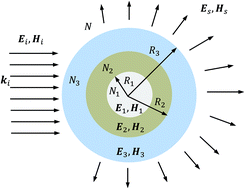High spectral field enhancement and tunability in core–double shell metal–dielectric–metal spherical nanoparticles†
Abstract
In this work we have developed full Mie theory for spherical core–double shell NPs, considering the boundary conditions of the electric and magnetic fields at each interface, to study plasmon resonances, optical extinction and spectral field enhancement of a generalized metal–dielectric–metal NPs. Keeping gold as the outer metal shell, calculations were carried out for different core metals (gold, silver, copper and aluminium) and different intermetallic dielectrics (silica, titanium dioxide, aluminium oxide and water). The metal dielectric function includes free and bound electron size corrections. Theoretical results show that the structures Al–SiO2–Au, Ag–SiO2–Au and Cu–SiO2–Au have field enhancement maxima factors of 33, 30 and 20 respectively in the outer region, all larger than that for Au–SiO2–Au (18). For the intermetallic region, field enhancement factors between 459, 960 and 841 are obtained for the first three structures mentioned before, respectively, also larger than that for Au–SiO2–Au (770). Spatial field enhancement was also calculated for both regions, for different core metals and fixed core–double shell size. A hybridization model specially developed for a core–double shell system allows an insightful interpretation of its plasmon resonances, field enhancement maxima and lack of symmetry in the outer region field distribution.


 Please wait while we load your content...
Please wait while we load your content...